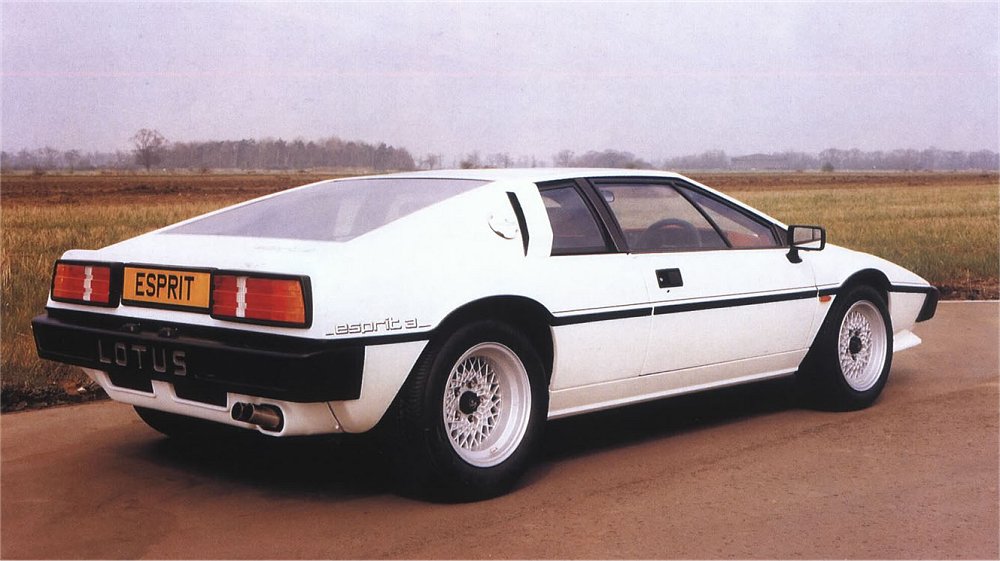Description
The Lotus Esprit S3 Turbo, introduced in 1981 and produced through the mid-1980s, represented the most mature and refined development of the first-generation Giugiaro-styled Esprit design. It evolved directly from the earlier Esprit Turbo launched in 1980 and carried forward both the performance enhancements and the visual drama that defined the turbocharged era of Lotus’s flagship sports car. The S3 Turbo was in many ways the car that realised the full potential of the original concept — combining the distinctive wedge styling with stronger performance, improved build quality, and greater everyday usability.
At its core, the Esprit S3 Turbo was powered by the Lotus Type 910 engine, a 2.2-litre all-aluminium, sixteen-valve, twin-cam four-cylinder fitted with a Garrett AiResearch T3 turbocharger. The engine produced around 210 horsepower and 200 lb-ft of torque, figures that were highly competitive for the time, especially given the car’s light weight of roughly 1,050 kilograms. Power was transmitted through a five-speed gearbox derived from the Citroën SM and Maserati Merak, driving the rear wheels. Performance was strong and immediate once the turbo spooled up, with 0–60 mph achieved in approximately 5.6 seconds and a top speed close to 150 mph. The car’s lightness and compact size gave it a responsiveness that few contemporary rivals could match, making it one of the most engaging driver’s cars of its decade.
The chassis was a further evolution of the steel backbone design that had been a Lotus hallmark since the 1960s. For the S3 Turbo, the structure was revised to improve torsional rigidity, while the suspension geometry was subtly retuned for better ride quality and stability at high speeds. The independent front and rear suspension used coil springs and telescopic dampers, with anti-roll bars at both ends. Combined with the car’s mid-engine layout and near-perfect weight distribution, this gave the Esprit S3 Turbo an outstanding balance between grip, agility, and composure. Steering was unassisted but beautifully direct and communicative, allowing experienced drivers to place the car with precision even at the limit. Braking was handled by four ventilated discs, ensuring strong and consistent stopping power.
Visually, the S3 Turbo refined the aggressive wedge shape introduced by Giorgetto Giugiaro for the original Esprit, adding aerodynamic and cosmetic updates that made it instantly identifiable as the turbocharged model. It featured deeper front and rear spoilers, integrated side skirts, distinctive side air intakes to feed the turbocharged engine, and rear buttresses that improved airflow. Many examples carried the iconic “Turbo Esprit” decals along the sills, often in contrasting colours to the bodywork. Alloy wheels — originally Speedline designs and later BBS cross-spoke types — completed the purposeful stance. The styling retained the sharpness of the early Esprit while achieving a more cohesive and aerodynamic appearance, with improved cooling and reduced lift at high speed.
Inside, the Esprit S3 Turbo was far more luxurious and comfortable than its predecessors. The cabin was trimmed in high-quality leather with thick carpeting and a redesigned dashboard that placed instruments more clearly within the driver’s view. The seats were deeper and more supportive, and the driving position was improved for comfort on long journeys. Standard equipment included air conditioning, electric windows, and a quality stereo system, with many cars also fitted with removable glass roof panels. The result was a cockpit that retained its driver-focused layout but felt more refined and livable than any previous Esprit.
On the road, the Esprit S3 Turbo offered a combination of precision and balance that defined Lotus engineering at its best. The turbocharged engine provided strong mid-range thrust, while the chassis delivered superb grip and feedback. Road testers of the period often described it as a car that rewarded skillful driving, capable of delivering high levels of performance without intimidation. Its ride quality was notably supple for a supercar, thanks to Lotus’s careful suspension tuning, and the overall refinement was a major improvement over earlier Esprit models.
The S3 Turbo also gained attention for its connection to Lotus’s Formula One programme, with technology and materials developed for the track influencing aspects of its design and construction. The car’s aerodynamics, weight distribution, and engine development all benefited from the brand’s racing experience. As the 1980s progressed, the Esprit S3 Turbo was further refined into the Turbo HC (High Compression) version, introduced in 1986, which increased engine output slightly and offered even smoother power delivery and improved efficiency.
Today, the Lotus Esprit S3 Turbo is widely regarded as one of the most balanced and collectible versions of the Giugiaro-era cars. It represents the point where Lotus successfully blended pure performance with genuine usability and comfort, before the restyled Stevens-designed Esprit of 1987 shifted the car into a new aesthetic phase. The S3 Turbo remains a vivid expression of 1980s British engineering ambition — lightweight, beautifully proportioned, and thrillingly direct to drive. For many enthusiasts, it stands as the definitive version of the early Esprit: a car that perfectly captures the character of Lotus at its creative peak.

